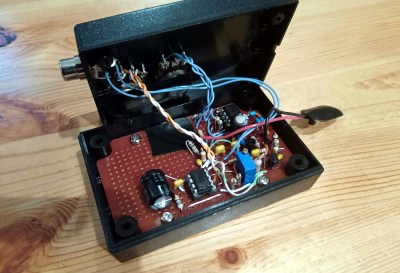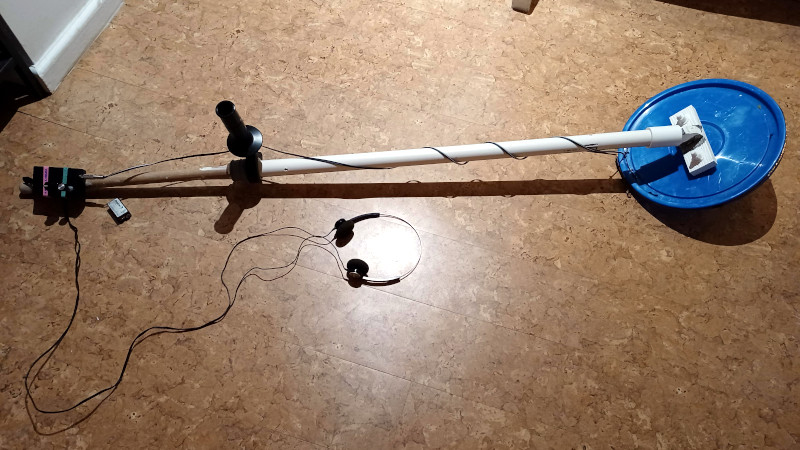Have you ever found yourself suddenly in need of finding a small metal object hidden in the woods? No? Well, neither have we. But we can’t say the same thing for [zaphod], who’s family was hoping to settle a dispute by finding the surveyor stakes that marked the corners of their property. It was a perfect job for a metal detector, but since they didn’t own one, a serviceable unit had to be assembled from literal garbage.
To start with, [zaphod] had to research how a metal detector actually works. After reviewing the pros and cons of various approaches, the decision was made to go with a beat frequency oscillator (BFO) circuit. It’s not the greatest design, it might even be the worst, but it could be built with the parts on hand and sometimes that’s all that matters. After packing a 2N3904 transistor, an LM386 amplifier, and every Hackaday reader’s favorite chip the 555 timer into an enclosure along with some of their closest friends, it was time to build the rest of the metal detector.

The sensor coil was made by salvaging the wire from an old fluorescent lamp ballast and winding it around the lid of a bucket 27 times. This was mounted to the end of a broom handle with some angle pieces made from PVC sheet material, being careful not to use any metal fasteners that would throw off the detector. With the handle of an old drill in the middle to hold onto, the metal detector was complete and actually looked the part.
So did [zaphod] save the day by finding the surveyor stakes and reconnoitering the family’s plot? Unfortunately, no. It wasn’t a technical failure though; the metal detector did appear to work, although it took a pretty sizable object to set it off. The real problem was that, after looking more closely into it, the surveyors only put down one stake unless they are specifically instructed otherwise. Since they already knew where that one was…
If your homemade metal detector can’t find something that was never there, did it really fail? Just a little something to meditate on. In any event, when even the cheapest smart bulb is packing a microcontroller powerful enough to emulate early home computers, we’re always happy to see somebody keep the old ways alive with a handful of ICs.















Cool build, i like the concept of using “scrap” for parts. And the used parts used are so recognizable that build is a joy to look at.
If one pin/stake is found and you have a copy of the deed, then you can determine the boundaries. Like George Washington, Mason and Dixon, and generations of surveyors did. The deed would have to contain a description of the property, other than lot so-and-so of such-and-such plat. The description uses “metes and bounds” which we would interpret as angles and distances. E, g., from the starting point, take prescribed direction/angle and proceed a stated distance. At the new point, rinse and repeat. Continue until the boundary lines close.
If your deed describes lots and plats, then you have to go to the county land records office and get a copy of that document. A lot more of rinse and repeat will take you to your lot, eventually.
Seems we’re pretty advanced here in South Africa, then. At least 99% of property survey records, some going back to the 1800s, are scanned and available online. http://csg.dla.gov.za/
Converting to modern units of measure is pretty easy (from British feet, and the morgen and square roods we inherited from the Dutch). Transforming to modern coordinate reference systems is sometimes a bit harder since such old survey diagrams are often referenced to a local reference system used at the time. In 1880, the Cape Datum was established, thanks to the work of some of Her Majesty’s Astronomers. Of course the country-wide system of surveyed points (trigonometric beacons) needed to reference any point in the country to that datum, was only established gradually after that. Since 1999 we’ve been based on the World Geodetic System, with a different datum
PS: I’ve personally dug for survey stakes in rural areas from old survey diagrams that were not referenced to a global datum :) Found some of them. One had been disturbed sometimes in the last 100 years, and was lying on it’s side underground where we found it, so had to be replaced at it’s original position. Still have the rusted century old original stake.
Good read, good writeup [zaphod]!
“If your homemade metal detector can’t find something that was never there, did it really fail?” – I’d say it failed and at the same time failed not. So it’s…
… Schroedinger’s failure.
It failed.
The surveyor could have chosen different corners of the property to stake out right? Should have used quantum effects so it could detect the stakes in any possible universe.
Kudos on the build! MacGyver would be proud. Nice job!
Have you ever found yourself suddenly in need of finding a small metal object hidden in the woods?
[zaphod] had to research how a metal detector actually works.
–
Doing research if you are suddenly in the need sounds odd.
It’s not like you suddenly need to take a dump whilst in the woods and start with researching on how to build a toilet ;)
Nice that “scrap” was used, but is there a schematic somewhere so that someone else could make one?
Hmm, it seems that the bits of schematic were posted two days ago. Oh well, carry on.
Love your presentation of the project, brief history of how and why you needed to “diy” on this and if I am correct in guessing-on probably everything you possibly can (I GET it,totally), and especially the quirky sense of humor… you must get it from [zaphod]!